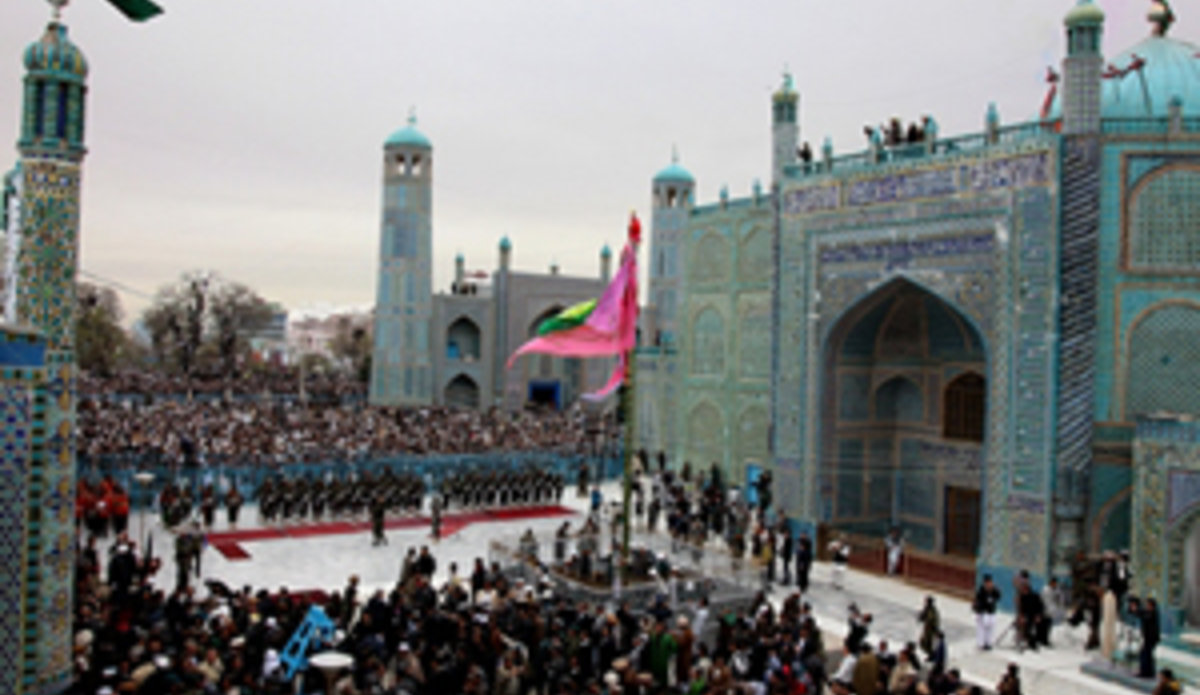Thousands celebrate Nowruz in Mazar-i-Sharif
22 March 2010 - From various parts of the country, including the remotest of locations, they came in thousands.
There weren’t half as many people as last year, still, enough crowds thronged to the northern city of Mazar-i-Sharif to celebrate Nowruz, the Afghan New Year.
As usual, the meeting point was the blue mosque of Mazar at the shrine of Hazrat Ali, the son-in-law of the Prophet, which is one of the main Shia sanctuaries, along with Mecca (in Saudi Arabia) and Karbala (in Iraq).
“I came from Tajikistan,” said Zabiullah, an Afghan expatriate now based in Dushanbe.
“It was a long way, but I felt it to be really important to be here with my family to celebrate this particular day. I wish this New Year will see peace and reconstruction efforts moving towards success,” he added, before joining the crowds of pilgrims gathered behind the fences of the shrine.
“Around 350,000 people have come this year,” according to Raffi, one of the organizers of the event.
“The crowds are not as much this year, because of insecurity, threats and bad weather conditions. We had two tragic events in the Salang Pass, the avalanche, in the recent past, and also a road incident yesterday. Maybe this discouraged people to come from Kabul. But, hopefully everything will take place in peace and fraternity,” he added.
On a cold and rainy morning yesterday, in the compound of the Blue Mosque which was decorated for this particular event, the ceremony started with a long and intense prayer dedicated to peace. Around the mosque, the crowds were silent and watchful. Some courageous pilgrims even climbed up trees so as not miss the ceremony.
Then, after a peace song offered to the audience by schoolgirls of Balkh, and a vibrant Afghan national anthem that echoed across the city of Mazar, Fayaz Mehareen, Cultural Advisor to the Balkh governor spoke to the guests.
“Nowruz is the identity of Mazar-i-Sharif since centuries,” he said. People from all across South East Asia usually come to celebrate this event here.”
Then Noor Mohammad Atta, Governor of Balkh province, addressed the crowd and called for sustainable development and security.
“The security of Balkh province is my number one priority. Enemies of Afghanistan have tried several times to disrupt Nowruz, but, fortunately, the police and security forces have prevented any major incident,” he said
Marshall Qasim Fahim, Afghanistan’s First Vice President was also present at the event.
“Nowruz was only an Afghan festival, but now that the United Nations has recognized it, it will appear in the international calendar of special days and will be known worldwide, which is a pride for us,” he said
After these speeches, the usual ceremony of Janda Bala – the rising of the holy flag in honour of Hazrat Ali – was welcomed by the crowd.
When the gates of the compound were finally opened to the public, thousands of people rushed in and touched the flag, which is a symbol of luck for the New Year.
Meantime, some Chopandaz (Buzkashi horsemen) rushed to the old Russian silo to participate in one of the most important matches of the year for Afghanistan’s national sport. More than 200 horsemen eventually contested in a stunning battle on Mazar’s muddy earth.
By the end of the afternoon, the rain began to fall. Nazir, an old man from Maimana, the capital of Faryab province, smiled when he was asked about his hopes for this New Year.
“Peace, security, development…these are hazy concepts. Progress in Afghanistan has to be made day after day. We need some concrete achievements,” he responded.
“Look, it is raining today,” he said pointing to the sky, “This will be good for agriculture. It is already a good sign, isn’t it?” he asked.
Late in the night, loud explosions shook the city of Mazar. The crowd, still making merry in the streets, looked skywards at the fireworks that illuminated the dark sky and marked a stunning closure to this important day.
Following Nowruz, the Gul-e-Surkh (red roses) festival starts for 40 days. Over the next few days, the shy spring sun will allow red flowers to bloom all over the green hills of the region making the north even more beautiful.
By Alexandre Brecher-Dolivet, UNAMA
 UN
UN







